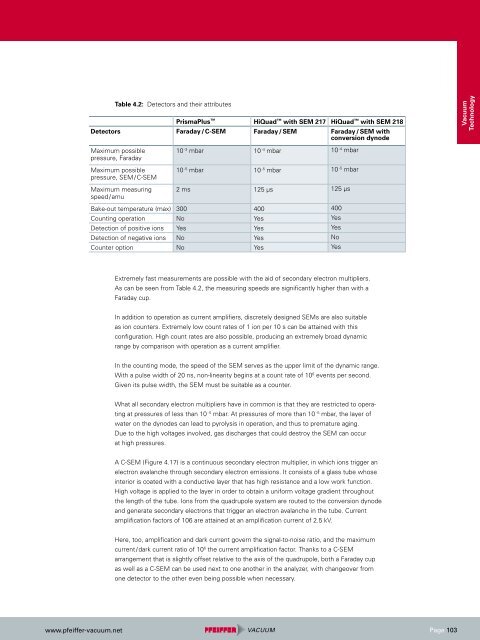You also want an ePaper? Increase the reach of your titles
YUMPU automatically turns print PDFs into web optimized ePapers that Google loves.
Detectors<br />
www.pfeiffer-vacuum.net<br />
Table 4.2: Detectors and their attributes<br />
PrismaPlus <br />
Faraday / C-SEM<br />
Maximum possible<br />
pressure, Faraday<br />
10<br />
Maximum possible<br />
pressure, SEM / C-SEM<br />
Maximum measuring<br />
speed / amu<br />
Bake-out temperature (max)<br />
Counting operation<br />
Detection of positive ions<br />
Detection of negative ions<br />
Counter option<br />
-3 mbar<br />
10 -5 mbar<br />
2 ms<br />
300<br />
No<br />
Yes<br />
No<br />
No<br />
HiQuad with SEM 217<br />
Faraday / SEM<br />
10 -4 mbar<br />
10 -5 mbar<br />
125 μs<br />
400<br />
Yes<br />
Yes<br />
Yes<br />
Yes<br />
HiQuad with SEM 218<br />
Faraday / SEM with<br />
conversion dynode<br />
10 -4 mbar<br />
10 -5 mbar<br />
125 μs<br />
400<br />
Yes<br />
Yes<br />
No<br />
Yes<br />
Extremely fast measurements are possible with the aid of secondary electron multipliers.<br />
As can be seen from Table 4.2, the measuring speeds are significantly higher than with a<br />
Faraday cup.<br />
In addition to operation as current amplifiers, discretely designed SEMs are also suitable<br />
as ion counters. Extremely low count rates of 1 ion per 10 s can be attained with this<br />
configuration. High count rates are also possible, producing an extremely broad dynamic<br />
range by comparison with operation as a current amplifier.<br />
In the counting mode, the speed of the SEM serves as the upper limit of the dynamic range.<br />
With a pulse width of 20 ns, non-linearity begins at a count rate of 106 events per second.<br />
Given its pulse width, the SEM must be suitable as a counter.<br />
What all secondary electron multipliers have in common is that they are restricted to operating<br />
at pressures of less than 10 - 5 mbar. At pressures of more than 10 - 5 mbar, the layer of<br />
water on the dynodes can lead to pyrolysis in operation, and thus to premature aging.<br />
Due to the high voltages involved, gas discharges that could destroy the SEM can occur<br />
at high pressures.<br />
A C-SEM (Figure 4.17) is a continuous secondary electron multiplier, in which ions trigger an<br />
electron avalanche through secondary electron emissions. It consists of a glass tube whose<br />
interior is coated with a conductive layer that has high resistance and a low work function.<br />
High voltage is applied to the layer in order to obtain a uniform voltage gradient throughout<br />
the length of the tube. Ions from the quadrupole system are routed to the conversion dynode<br />
and generate secondary electrons that trigger an electron avalanche in the tube. Current<br />
amplification factors of 106 are attained at an amplification current of 2.5 kV.<br />
Here, too, amplification and dark current govern the signal-to-noise ratio, and the maximum<br />
current / dark current ratio of 106 the current amplification factor. Thanks to a C-SEM<br />
arrangement that is slightly offset relative to the axis of the quadrupole, both a Faraday cup<br />
as well as a C-SEM can be used next to one another in the analyzer, with changeover from<br />
one detector to the other even being possible when necessary.<br />
Page 103<br />
<strong>Vacuum</strong><br />
<strong>Technology</strong>

















